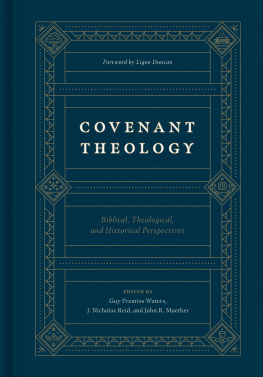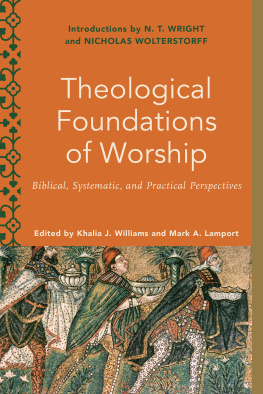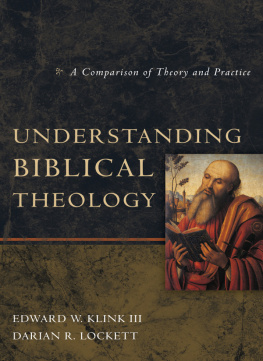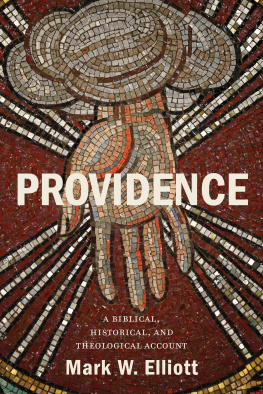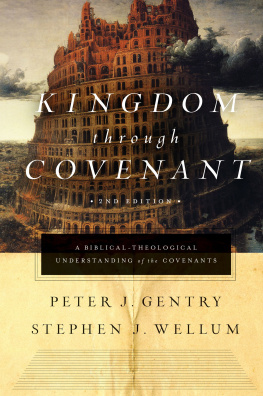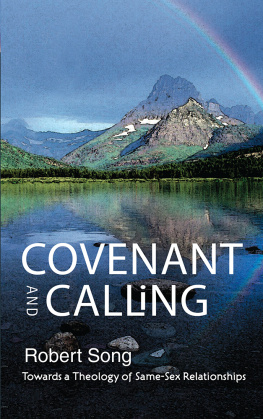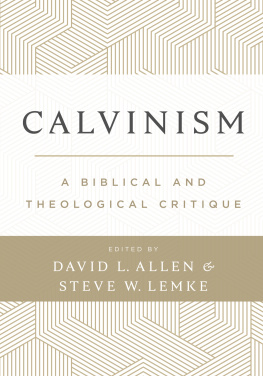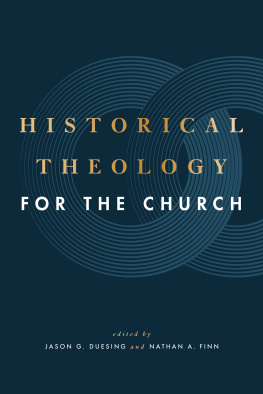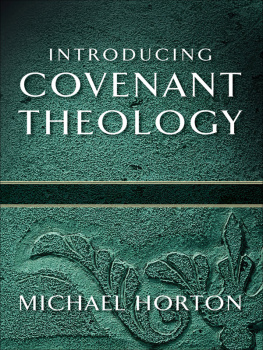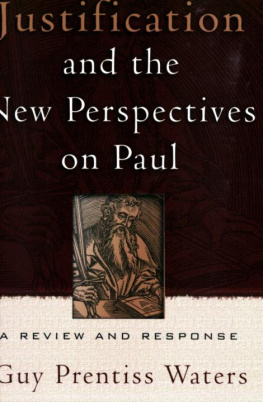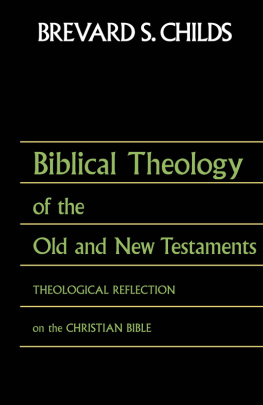Guy Prentiss Waters (editor) - Covenant Theology: Biblical, Theological, and Historical Perspectives
Here you can read online Guy Prentiss Waters (editor) - Covenant Theology: Biblical, Theological, and Historical Perspectives full text of the book (entire story) in english for free. Download pdf and epub, get meaning, cover and reviews about this ebook. year: 2020, publisher: Crossway, genre: Religion. Description of the work, (preface) as well as reviews are available. Best literature library LitArk.com created for fans of good reading and offers a wide selection of genres:
Romance novel
Science fiction
Adventure
Detective
Science
History
Home and family
Prose
Art
Politics
Computer
Non-fiction
Religion
Business
Children
Humor
Choose a favorite category and find really read worthwhile books. Enjoy immersion in the world of imagination, feel the emotions of the characters or learn something new for yourself, make an fascinating discovery.
- Book:Covenant Theology: Biblical, Theological, and Historical Perspectives
- Author:
- Publisher:Crossway
- Genre:
- Year:2020
- Rating:5 / 5
- Favourites:Add to favourites
- Your mark:
- 100
- 1
- 2
- 3
- 4
- 5
Covenant Theology: Biblical, Theological, and Historical Perspectives: summary, description and annotation
We offer to read an annotation, description, summary or preface (depends on what the author of the book "Covenant Theology: Biblical, Theological, and Historical Perspectives" wrote himself). If you haven't found the necessary information about the book — write in the comments, we will try to find it.
Covenant Theology: Biblical, Theological, and Historical Perspectives — read online for free the complete book (whole text) full work
Below is the text of the book, divided by pages. System saving the place of the last page read, allows you to conveniently read the book "Covenant Theology: Biblical, Theological, and Historical Perspectives" online for free, without having to search again every time where you left off. Put a bookmark, and you can go to the page where you finished reading at any time.
Font size:
Interval:
Bookmark:
The Covenant of Works in the New Testament
Guy Prentiss Waters
Few contemporary New Testament scholars acknowledge the presence of the covenant of works in the text of the New Testament. The New Testament writers, and particularly the apostle Paul, understand God to have entered into a covenant with Adam sometime after God created Adam but before Adam first sinned against God. In this covenant, Adam served as a representative man. That is, the fate of Adams descendants ( Jesus excepted) was suspended on Adams actions in covenant with God. God required of Adam ongoing obedience to the moral commandments that had obliged him since his creation. God also required of Adam obedience to the superadded command not to eat of the tree of the knowledge of good and evil. Had Adam continued in obedience to God, he would have brought himself and his posterity into confirmed, unlosable life. But Adam disobeyed and so plunged himself and his descendants into sin, curse, and death in all its forms. It is this covenantal framework that provides the context within which the New Testament speaks of the person and redemptive work of the last Adam, Jesus Christ.
5) but also to those passages that have suggested to some readers an association between that covenant and the Mosaic covenant. After reviewing these passages, we address the implications of what Paul says about the covenant of works for our understanding of the Bible and of the Christian life.
The Covenant of Works
1 Corinthians 15
Pauls earliest formulation of the covenant of works appears in 1 Corinthians 15. He addresses the covenant of works in the context of an extended reflection on the That is, he addresses the nature of the resurrection body and the way we will receive the resurrection body at Christs return.
In each of the latter two sections of this long argument (15:2023, The result of the action of the one representative man, Paul clarifies, is determinative of the destinies of the represented: For as in Adam all die, so also in Christ shall all be made alive (15:22).
Paul here describes Jesus as the firstfruits of the resurrection harvest:
Christ has been raised from the dead, the firstfruits of those who have fallen asleep. (15:20)
But each in his own order: Christ the firstfruits , then at his coming those who belong to Christ. (15:23)
First, in his resurrection, Christ has begun the resurrection harvest of the age to come. The inbreaking of the age to come, therefore, has already begun but is not yet consummated.
This observation hardly exhausts the significance of Christ as firstfruits of the resurrection harvest in the age to come. There is a second and equally important point that Paul is making here. The firstfruits bears an organic connection and unity with the remaining harvest, such that there is an inseparability of the initial quantity with the whole.
Paul expands these observations in a second important point that he develops later in the argument of 1 Corinthians
What is striking is that Adam is in view in these verses not primarily as the one through whom sin entered the world but as the one whom God created in uprightness and integrity.
What, then, characterizes or distinguishes the eschatological order inaugurated by Christs resurrection from the preeschatological order inaugurated by the creation of Adam? In 1 Corinthians 15:45b, Paul affirms that whereas Adam became a living being, the last Adam became life-giving Spirit (my trans.; ESV: a life-giving spirit). The two words translated being () and Spirit () in 15:45 are cognate with the adjectives translated natural () in 15:44 and Spiritual () in 15:46. These two words in 15:45 therefore reflect the difference between the two Adamic orders that Paul is contrasting in 15:4249.
How should we understand Pauls phrase life-giving Spirit? I have capitalized the noun Spirit in my translation because Paul is surely speaking here of the Holy Spirit. Since two uses of the adjective Spiritual () bracket the cognate noun in 15:45 (), we should understand that noun to refer to the third person of the Godhead, the Holy Spirit.
That conclusion raises yet another question. What does Paul mean when he says that Christ became life-giving Spirit? He cannot be confusing or mixing Christ and Spirit as two distinct persons, since elsewhere in his letters he takes care to make personal distinctions between the two (cf. Rom. 8:911). In other words, Paul is not erasing the distinction between the person of the Son and the person of the Spirit. He is, however, making an economical or functional identification of Christ and the Spirit (cf. 2 Cor. 3:17). This identification took place at the resurrection, when Christ was raised from the dead by the power of the Holy Spirit (cf. Rom. 8:11; Eph. 1:1920). Gaffin explains the significance of what transpired at the resurrection:
At his resurrection the personal mode of Jesus existence as the last Adam was... decisively transformed by the Holy Spirit. The Spirit, who raised him up as the firstfruits, indwells him so completely and in such a fashion that in their functioning he is the Spirit who will be instrumental in the resurrection of the full harvest.... Only by virtue of the functional identity of the Spirit and Christ, effected redemptive-historically in his resurrection, is Christ the communicator of life.
In light of what Paul has argued earlier in 1 Corinthians 15, and in light of what Paul goes on to say in 15:4649, we may begin to bring this discussion of 15:45b and of 15:4249 to a close with two concluding considerations.
We are now in a position to summarize Pauls statements in 1 Corinthians 15 in relation to the covenant of works. For Paul, Adam and Christ are representative persons. Every ordinary human being claims either Adam or Christ as his representative. Adam and Christ each stand at the head of a distinct eschatological order. Adam stands over the preeschatological order. Had Adam obeyed, he would have brought himself and his posterity into confirmed eschatological life. Adam, however, disobeyed God. In doing so, he plunged himself and his posterity into a state of sin and misery. Death in all its forms, not life, is the just outcome for Adam and all those who are in Adam.
Christ, however, stands over another order. This order was inaugurated in history by his resurrection from the dead in the power of the Holy Spirit. When Christ was raised, he entered into confirmed eschatological life. This life he merited by his obedience, an obedience that led to his accursed death on the cross (Gal. 3:1014; Phil. 2:8) and that eventuated in his resurrection from the dead (Rom. 4:25). Christ freely and graciously shares this life with all those who are in him. When God graciously transfers a person from being in Adam to being in Christ, God brings that person from the realm of sin, curse, and death into the realm of righteousness, blessing, and life.
Romans 5
In Romans 5:1221, Paul revisits the two Adams in the context of the exposition of his gospel (1:1617). He does not, however, merely restate what he said about the two Adams in 1 Corinthians 15. He builds on and advances that teaching in such a way as to help us appreciate the glory of Christ and the sufficiency of his work for our salvation.
There is one important difference between the way Paul portrays Adam in 1 Corinthians 15 and the way he portrays him in Romans 5:1221. 2:7). In Romans, however, Paul reflects on Adam in light of his first sin against God. The burden of Romanss exposition of Adam is to show how his first transgression plunged him and his posterity into ruin and misery.
There is also a difference between the way Paul portrays Christ in 1 Corinthians 15 and the way he portrays him in Romans 5:1221. In 1 Corinthians 15, Paul emphasizes the epochal resurrection of Christ and the fruit of that work for all who are in Christ. In Romans 5:1221, however, Pauls chief concern is the obedience and
Font size:
Interval:
Bookmark:
Similar books «Covenant Theology: Biblical, Theological, and Historical Perspectives»
Look at similar books to Covenant Theology: Biblical, Theological, and Historical Perspectives. We have selected literature similar in name and meaning in the hope of providing readers with more options to find new, interesting, not yet read works.
Discussion, reviews of the book Covenant Theology: Biblical, Theological, and Historical Perspectives and just readers' own opinions. Leave your comments, write what you think about the work, its meaning or the main characters. Specify what exactly you liked and what you didn't like, and why you think so.

